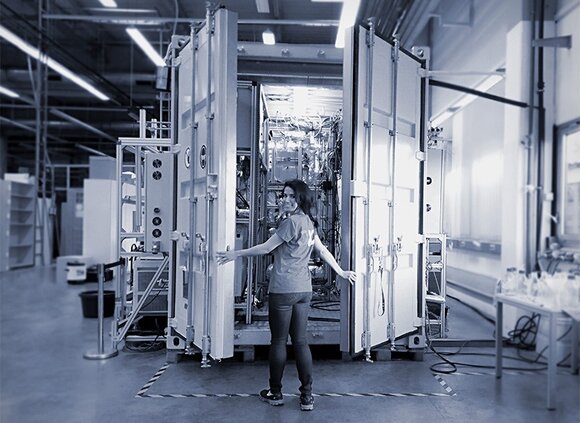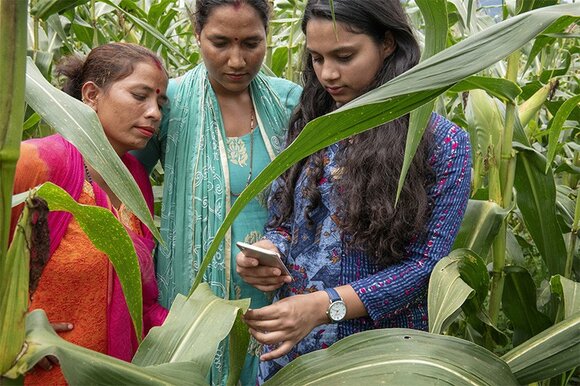
Ida Tin (left) and Lynae Brayboy. Their smartphone app, Clue, offers tools and information surrounding reproductive health.
Credit: Gene Glover for Nature
Germany’s start-up scene is booming
With record levels of funding, German start-ups are building the nation’s strength in innovation.
26 November 2020

Gene Glover for Nature
Ida Tin (left) and Lynae Brayboy. Their smartphone app, Clue, offers tools and information surrounding reproductive health.
Germany’s start-up scene is thriving. In 2019, its start-ups (companies less than 10 years old) raised a record €6.2 billion (US$7.3 billion) from public and private investments, an increase of 36% on the previous year. More than half of it went to Berlin, one of Europe’s leading destinations for entrepreneurs.
Many start-ups springing from German universities and research institutes have received funding through the federal government’s EXIST programme, an initiative to boost the country’s edge in innovation.
Since 2006, EXIST has given out roughly €500 million to more than 2,000 projects, including INERATEC, a spin-off from the Karlsruhe Institute of Technology, and Morpheus Space, a spin-off from the Dresden University of Technology.
It’s striking that the proportion of female start-up founders in Germany is only 15.7%, according to the Female Founders Monitor, a report published by Google for Startups. Similar numbers have been reported for London and Silicon Valley, California. Ida Tin, founder of Berlin-based start-up, Clue, and Simone Strey, founder of PEAT, also featured here, are among the women making their mark.
Fertility tracker
Menstruation database informs reproductive health decisions
Frustrated by the lack of online information about menstruation and fertility, Ida Tin established Clue, a Berlin-based start-up that launched a period and ovulation tracker app in 2013. “I couldn’t understand how human beings had managed to walk on the Moon, but had not managed to support women in finding out which days they can or can’t get pregnant,” says the Danish entrepreneur, who moved to Germany to establish the company.
Clue users can enter data on more than 30 categories, such as food cravings, sex drive, mood and pain, which informs predictions related to their menstrual cycle. The app, which uses artificial intelligence to predict the user’s next period, has grown to attract more than 13 million active users since its launch. By 2017, the company had raised approximately €25 million in funding.
Clue now maintains one of the world’s largest publicly sourced databases on menstruation, says Tin. It has established research partnerships with some of the world’s most high-profile institutions, including the Max Planck Society in Germany, the University of Oxford, UK, and Stanford University in California. Using data collected by the app, researchers are investigating various aspects of female health, from psychological changes that occur during ovulation to poorly understood diseases such as endometriosis.
One of the major contributors to the company’s success, says Tin, is the lure of working in Berlin, a city known for its affordability, quality of life and diverse expatriate communities.
Lynae Brayboy, a reproductive scientist from Brown University in Rhode Island, for example, relocated from the United States to join Clue as its first chief medical officer in July 2020, while on a five-month sabbatical at the Berlin Institute for Advanced Study in Grunewald, which offers fellowships to researchers in the natural and social sciences.
Part of Brayboy’s new role involves educating health-care providers on how patients from understudied or marginalized groups experience issues related to menstruation and fertility. This includes leading a free webinar series for clinicians on improving racial and ethnic health disparities. “We are in a unique position to provide sexual health information to both the user and scientific community,” says Brayboy. — by Gemma Conroy
Launchpad for opportunity
Lightweight steering system makes satellites more useful
It’s been a decade since Daniel Bock started tinkering with a big idea for a tiny product: a miniature propulsion system that could power and steer CubeSat satellites without adding too much bulk. At the time, it was an idea in search of a market.
Only a few CubeSats — satellites measuring 10 cm³ that hitch a ride on larger launches and typically fly in low-Earth orbit (under 1,000 km in altitude) — had ever been launched. With no on-board propulsion, the earliest CubeSats were intended as simple educational devices for engineering students. Their applications in remote sensing and interplanetary missions had yet to be realized.
“Ten years ago, nobody could imagine that a CubeSat could host a propulsion system,” says Bock, who first worked on the idea as an engineering master’s student at the Dresden University of Technology (TU Dresden). “We wanted to make small satellites more useful and increase their commercial applications.”
CubeSats, which can fit together like building blocks, have since soared in popularity. Propulsion systems have given users greater control over their orbits, and they’re now used by research institutions and companies to monitor farmland conditions, climate impacts and natural disasters. In 2018, NASA was the first to launch CubeSats into deep space.

Morpheus Space
Bock is now chief executive of Morpheus Space, a company he co-founded in 2018 as a spin-off from TU Dresden with funding from Germany’s EXIST programme, an incubator that supports start-ups founded by students and academics.
Its flagship product is a field-emission electronic propulsion (FEEP) device that uses liquid gallium, a soft, highly reflective metal often used in electronic circuits, as a propellant for CubeSats. Up to eight thrusters can fit on one CubeSat.
“Our system is highly efficient and doesn’t interfere with the design of the satellite,” says Bock. “In the past, you had to build the satellite around the propulsion system.”
Each thruster, which is about the size of a fingertip, provides up to 40 micronewtons of force. That’s barely enough to budge a grain of salt on Earth, but it can propel a CubeSat in space. “Satellites in orbit can change their speed even with the smallest forces that act continuously over a long time,” says Morpheus Space president and co-founder, István Lőrincz.
In 2019, Morpheus Space secured an order from NASA’s Jet Propulsion Laboratory, and in July 2020, its thrusters were used by a CubeSat launched by researchers at the University of Würzburg in Germany, to avoid a collision with a radio satellite.
Morpheus Space is now working on ‘autopilot’ software that allows users to easily redirect satellites to new locations in orbit to observe particular locations on Earth. — by Chris Woolston
Fuel to go
Portable power plants convert surplus renewable energy
By 2030, Germany hopes to derive 65% of its energy from renewable sources, up from about 50% today. But switching from nuclear power and coal requires storage solutions for the surplus power generated by solar, wind and hydropower facilities.
Enter INERATEC, founded in 2016 by researchers from the Karlsruhe Institute of Technology (KIT) in southwestern Germany. Its chemical reactors convert excess renewable power and industrial waste gases into liquid fuels, such as diesel, kerosene and petrol, all in mobile units the size of shipping containers.
Whereas conventional gas-to-liquid conversion processes require expensive large-scale infrastructure, INERATEC chemical plants can operate in a variety of industrial settings, from solar and wind farms to sewage plants and oil facilities. The units, sold separately, are stackable, and the more that are connected, the larger and more powerful the plant.
“Most chemical plants are built once and take up a lot of space,” says Philipp Engelkamp, co-founder and chairperson of INERATEC. “We take a modular approach that can be customized for different clients.”

INERATEC
Government funding was a major contributor to INERATEC’s early success, which included around €1 million from the EXIST programme. Engelkamp and his two co-founders used the two-year funding to develop a demonstration plant at a research facility at KIT in 2016.
“The idea became reality for the first time,” says Engelkamp. “It also became tangible and understandable for customers.” Engelkamp say they were able to move their technology to market relatively quickly, with Audi and the VTT Technical Research Centre of Finland, a state-owned and controlled non-profit organization, among their first customers.
INERATEC now has 11 demonstration gas-to-liquid chemical plants operating in Germany, Spain and Finland. The start-up is also building two industrial-scale plants in Germany that will produce fuel for the aviation sector, with one set to begin operating in 2021.
In July 2020, INERATEC partnered with Swiss multinational chemicals company, Clariant. The aim is to develop more efficient ways of producing affordable renewable fuels and chemicals using Clariant’s expertise in catalysts to convert carbon dioxide into methanol and synthetic natural gas.
“Our main goal is to establish strategic partnerships between market leaders for catalysts and our efficient reactor systems,” says Engelkamp. — by Gemma Conroy
Reaping high-tech rewards
A smartphone app offers large-scale solutions for crop development
To help farmers meet food demands, the burgeoning agricultural technology (agtech) industry offers all manner of robotics, wireless networks, sensors and analysis software to maximize yield. But these tools are priced out of reach of many small farmers, who feed up to 80% of people in Asia and sub-Saharan Africa.
After more than a decade working with farmers across Africa, geobotanist and soil-scientist Simone Strey teamed up with six other specialists in plant pathology, artificial intelligence and sociology to co-found PEAT, an agtech company focused on making digital farming solutions more affordable.
A spin-off from the Institute of Soil Science at Leibniz University Hannover, where Strey was previously based, PEAT was launched in Berlin in 2015 with Strey as chief executive. The company secured initial funding from EXIST and has since raised €12.6 million in investments to develop Plantix, a free mobile crop advisory app.
Using image recognition software, Plantix analyses crop photos to diagnose diseases, pest damage and nutrient deficiencies instantly, and advise treatments. Accessed by one million users each month, it’s one of the world’s largest agtech apps. “We’ve trained machine learning algorithms to become digital plant experts,” says Strey.

Chris de Bode/CGIAR/Panos
Plantix draws on a database of 25 million crop photos uploaded by farmers, mostly based in India, as well as locations such as Pakistan, Bangladesh and Brazil. In 2019, PEAT pitted the app against 127 agronomists (researchers who work in soil management and crop development) in diagnosing wheat and maize diseases, based on photos.
“Plantix’s algorithms achieved 93% accuracy, compared with 72% from the agronomists,” says Strey.
PEAT’s focus now is on automating the process for farmers, from the initial diagnosis of the crop disease, to ordering and receiving treatments from local retailers and manufacturers. According to PEAT co-founder and rural sociologist, Korbinian Hartberger, more than 20,000 shops have joined the Plantix network.
One of the aims of facilitating these connections between the farmers and the suppliers is to generate a revenue stream to continue developing the app.
Plantix is also assisting farmers in tracking the spread of diseases and pests across vast regions. In 2018, a voracious insect called the fall armyworm was detected in India for the first time. “Within two weeks we had the disease automated into our system,” says Strey. The app’s geo-tagging software informed a map that now monitors the spread of fall armyworms across India in real time. — by Natalie Parletta
This story is part of Nature Index 2020 Germany. See more stories here.
